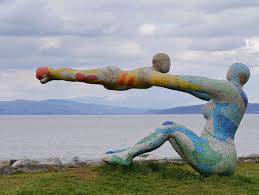
A case can be made that all art is an expression of love. The very act of creation may be a bursting forth of love. There it is on the canvas. There it is on the page. There it is in the music, on the dance floor, on the stage.
I hope in this post to illustrate how art in its many forms is love manifest. It may not always strike an aesthetic chord and maybe it’s downright irritating to the observer experiencing it, but the source of the sprouting seed from which it germinates is the same life force that brings us our most cherished art.
Some Blazing Examples
Music is a treasure trove of cases in point. Vivaldi’s Four Seasons would qualify, in my opinion, along with many other classical pieces. Works of Mozart and Rachmaninoff come to mind right away. Rock, folk, jazz, blues and country music gave us contributions like Love Song by Elton John, All You Need is Love by the Beatles and Back Home Again by John Denver.
Books such as Siddhartha by Hermann Hesse, The Magic Garden by Frances Hodgson Burnett and The Prophet by Kahlil Gibran are a few of many tomes swelling with love from cover to cover.
In the world of painting, what could speak love more eloquently than Michelangelo’s frescoes on the ceiling in the Sistene Chapel? In dance, nothing demonstrates the joy of romantic love better than Singin’ in the Rain. While there are many films that give us stirring romance, Titanic showed as well as any how deep love can go.
It’s easy to recognize love in art through these magnificent works, but let’s challenge ourselves. Let’s open our minds a little to find it dressed in other not-so-pleasant garb.
Burnin’ Down the House

I’ll tell you what comes to mind when I go searching for loving art in disguise. It’s heavy metal music. Guttural voices, pounding rhythms and grating instruments that could set your teeth on edge. Keep in mind, though, that metal fans are rabidly loyal. They may be most excited about their bands when they’re teenagers, but they still love them when they’re bonafide grown-ups. I would contend also that those musicians playing this music are doing so because they love it. The lyrics can also be endorsing deep spiritual compassion, couched in language reminding us who we are. My son played the latest Tool album for me recently. It’s called Fear Inoculum. Check out part of their message from this song, Pneuma.
We are spirit Bound to this flesh We go around one foot nailed down We’re bound to reach out and beyond this flesh become Pneuma
We are will and wonder Bound to recall, remember (We are born of) One breath, one word (We are all) One spark, sun becoming
Child, wake up Child, release The light Wake up now, child, wake up Child, release The light Wake up now, child
(Spirit) (Spirit) (Spirit) (Spirit)
One of the most violent and disturbing television shows of all time, Breaking Bad, had as its basic premise the intention of a secretly dying high school Chemistry teacher to leave his family all the support financially they would need in his absence. His decision to raise a fortune by making and selling meth led to major complications and some pretty ugly actions arising from his need to survive long enough to realize his goal. Still, love for family was the initial driving force for this character.
Hate and Love
All well and good as far as those examples go, you may be thinking. Exceptions to the rule do not a rule make. It’s absurd that all art is an expression of love, right? I mean, where’s the redeeming quality in a song that speaks forcefully about killing cops? Or where’s the love in a manifesto that declares oppressive intentions toward a group of people?
I once wrote an angry song about a woman who had the good sense to break off our relationship when she saw that we weren’t compatible. I penned a scathing assessment of her mental condition and sang it with vitriolic passion. I think it’s vital to look at the source of these feelings that produce such anger and hate that we sublimate into our art.
As humans, we are basically animals. As spiritual beings, we are so much more. Most people identify more with their bodies than they do with their higher selves. We are pack animals on that most basic level. As such, we have a strong urge for affinity. My dictionary tells me affinity is a natural liking or attraction. It’s natural to like others and want to be close to them. We care about those in our pack and we would defend them against attack. This is love…uncomplicated when sane, pure when simple.
Being rejected by the pack creates a sense of separation. There’s enforced distance, thus diminished affinity. It can lead to anger, hate and retaliation to being pushed away. The artist who experiences this is inclined to produce art that reacts to the unwanted condition of being thrust from the circle of love. They would much rather be wrapped in the loving embrace of their community. The love that naturally emanates from the source of life within the person meets with the rejection and cries out in pain as creatively as it can. Figuratively speaking, it screams or growls or moans in dark art that demands reciprocation. Love’s protest is registered on the canvas of humanity’s matrix, but always retains its identity as love.
Don’t Be Fooled
When you see the twisted and disturbing piece of sculpture or the violent movie or a grotesque portrait of a vicious man, don’t look upon it in disgust and certainly do not reject the creator of this art. Don’t judge this person to be cold or hard or mean. Look deeper and try to find the expression of love giving rise to what bubbled to the surface.
